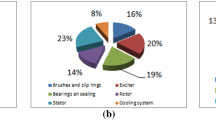Abstract
In order to carry out machine fault diagnosis earlier and more accurately such as the automatic detection for the ship’s level scale, and the existing literatures didn’t discuss these until now. However, for solving the problem, this paper presents a semigroup of fuzzy automata and its properties, constructs a fuzzy inference system on the semigroup of fuzzy automata, and discusses its application on machine fault diagnosis and the anti-fatigue driving reminder device. At the same time, the comparison between this inference model and the existing diagnosis methods is discussed. The experimental results show that the diagnosis speed and the average precision of the proposed inference model are faster and higher than those of traditional methods, which their maximum diagnosis precision is 95.98%.










Similar content being viewed by others
References
Shamsizadeh M (2016) Intuitionistic general fuzzy automata. Soft Comput 20(9):3505–3519
Directable KV (2015) Fuzzy Automata. International Journal of Computer Applications 125(8):1–4
Yongzhi C, Yoshinori E (2012) Nondeterministic fuzzy automata. Inf Sci 191(1):86–97
Jancic Z, Micic I, Ignjatovic J, Ciric M (2016) Further improvements of determinization methods for fuzzy finite automata. Fuzzy Sets Syst 301(10):79–102
Wu QE, Wang T, Pang X, Huang Y-X, Li J-S (2007) Discussion of relation of fuzzy automata. Journal of Information and Decision Science 2(4):349–357
Lvzhou L, Daowen Q (2015) On the state minimization of fuzzy automata. IEEE Trans Fuzzy Syst 23(2):434–443
Moghari S, Zahedi MM (2014) Minimization of deterministic fuzzy tree automata. Journal of Fuzzy Set Valued Analysis 2014(1):1–18
de Mendivil JRG, Garitagoitia JR (2014) Determinization of fuzzy automata via factorization of fuzzy states. Inf Sci 283(1):165–179
Stamenkovic A, Ciric M, Ignjatovic J (2014) Reduction of fuzzy automata by means of fuzzy quasi-orders. Inf Sci 275(3):168–198
Albrycht J, Wisniewski H (1983) Concept on fuzzy set. Proceedings Polish Symposium on Interval and Fuzzy Mathematics. Poznan', Poland
Turksen IB, Yao DD (1984) Representation of connectives in fuzzy reasoning: the view through normal forms. IEEE trans. Systems. Man and Cybernetics 14:146–151
Wenyi Z, Hongxing L (2006) Relationship between similarity measure and entropy of interval valued fuzzy sets. Fuzzy Sets Syst 157(2):1477–1484
Mendivil JRGD (2018) Conditions for minimal fuzzy deterministic finite automata via Brzozowski's procedure. IEEE Trans Fuzzy Syst 26(4):2409–2420
Gao Z, Wu QE, Hu C, Xiaoliang Q, Wang Y, Huanlong Z (2018) Target classification by constructing fuzzy automata system. International Journal of Fuzzy Systems 20(8):2620–2631
Du Y, Zhu P (2018) Fuzzy approximations of fuzzy relational structures. Int J Approx Reason 98:1–10
Williamal GWEE, Fu KS (1969) A formulation of fuzzy automata and its application as a model of learning systems. IEEE Transactions on Systems Science and Cybernetics SSC-5(3):215–223
Krohn K, Rhodes J (1965) Algebraic theory of machines. I Prime decomposition theorem for finite semigroups and machines Transactions of the American Mathematical Society 116:450–464
Yang L, Yong Q, Jinsong H, Wang C, Yunhao L (2015) Shelving interference and joint identification in large-scale RFID systems. IEEE Transactions on Parallel and Distributed Systems 26(11):3149–3159
Shuang W, Lan S (2017) Maximum principle for partially-observed optimal control problems of stochastic delay systems. Journal of Systems Science & Complexity 30:316–328
Guangle Y, Tao L, Jiandan Z, Ping J (2019) Learning multi-temporal-scale deep information for action recognition. Appl Intell 49(6):2017–2029
Tarn T, Rasis Y (1975) Observers for nonlinear stochastic systems. IEEE Trans Autom Control 21(4):441–448
Tateno Shigeyuki, Guan Xia, Cao Rui, Qu Zhaoxian (2018) Development of Drowsiness Detection System Based on Respiration Changes Using Heart Rate Monitoring. 2018 57th annual conference of the Society of Instrument and Control Engineers of Japan (SICE), Nara, Japan, SEP 11-14, 1664–1669
Wang J, Yu X, Qiang L, Yang Z (2019) Research on key technologies of intelligent transportation based on image recognition and anti-fatigue driving. EURASIP Journal on Image and Video Processing 33(1):21–33
Acknowledgements
This work is supported by Center Plain Science and Technology Innovation Talents (194200510016); Science and Technology Innovation Team Project of Henan Province University (19IRTSTHN013); Zhengzhou Science and Technology Innovation Talents (192101059006); National Natural Science Foundation of China (61973104, U1604151); Key Science and Technology Program of Henan Province (172102310447), respectively.
Author information
Authors and Affiliations
Corresponding authors
Additional information
Publisher’s note
Springer Nature remains neutral with regard to jurisdictional claims in published maps and institutional affiliations.
Rights and permissions
About this article
Cite this article
Wu, Q.E., Guang, M., Chen, H. et al. Semigroup of fuzzy automata and its application for fast accurate fault diagnosis on machine and anti-fatigue control. Appl Intell 50, 1542–1557 (2020). https://doi.org/10.1007/s10489-019-01611-4
Published:
Issue Date:
DOI: https://doi.org/10.1007/s10489-019-01611-4




